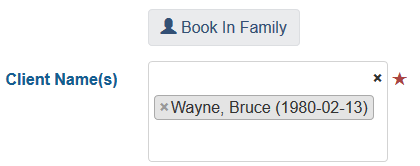
Occasionally, I get asked by someone what is the average length of stay for families (as opposed to singles) in their shelter system. On the surface, this is an innocent question! I would like to know this. Wouldn't you like to know? If families are staying longer than singles, then maybe we can arrange some policies or programs that specifically target families more efficiently.
But it's actually really hard to calculate the average length of stay for a family. Not because the math is hard, but because the definitions are hard. You have to be really specific what you are counting and averaging.
Definition 1: What is a Stay?
The first thing we need to be clear on is what constitutes a Stay. Officially-unofficially, a stay lasts from when a client books in to when a client books out. That's one stay record so if you don't otherwise specify, I assume that's what you mean when you say "Stay." However, some shelters are in the practice of booking clients out every morning and booking them in every evening, so literally every single Stay, according to this definition, is a single night. It would not be terribly useful to look up the average stay in this context. It is possible to glue subsequent Stays together, but that's an added degree of difficulty so it's not generally done, unless specifically requested.
Definition 2: What constitutes a Family Stay?
You may recall a previous blog post in which we talked about Family Stays in HIFIS 4. In it, we pointed out that stays for people in a group are not actually linked together. It is, actually, a bit challenging to decide which stays are Family Stays and which are Single Stays. What is normally done is to check and see if the client was part of a Family at the time of the Stay. If so, it's a Family Stay; if not, it's a Single Stay. However, this can be fun if, say, the family shelter is running out of beds and perhaps dad goes to stay at the men's shelter for a few days...
But let's assume that you know how you want to define a Stay, and also how you want to define a Family Stay.
Definition 3: Family Length of Stay
You probably haven't thought about this before, but when you describe "the length of stay of a family," what exactly are you counting?
To illustrate, let's imagine we have a family of four:
- Mama Bear (family head) stays from Jan 1 to Jan 13, then spends a night in lockup (total of 12 nights)
- Papa Bear (partner) is in detox, but joins the family from Jan 4 to Jan 14 (total of 10 nights)
- Brother Bear (child) is a teenager and stays with the family from Jan 1 to Jan 9, then stays with his buddy for a few nights and then comes back Jan 12 to Jan 14 (8 nights, then 2 nights, for a total of 10 nights)
- Sister Bear (child) stays with the family the whole time (total of 13 nights)
The length of stay for this family might be:
- The length of the family head's stay, which is 12 nights (Mama Bear)
- The length of the longest stay for any member of the family, which is 13 nights (Sister Bear)
- The number of nights between when the earliest family member booked in (Jan 1) to when the last family member booked out (Jan 14). This is also 13 nights, the same as Sister Bear, but it could be a different value for a different example family
- An average of all the stays for all of the family members: (12 + 10 + 8 + 2 + 13) / 5, which is 9 nights
- And then, if you're looking at different definitions of Stay, we could use an average of all the bed nights for all of the family members in this episode (12 + 10 + 10 + 13) / 4 = 11.25 nights
- Or, counting the days that Brother Bear wasn't in shelter as part of the episode, (12 + 10 + 13 + 13) / 4 = 12
So... that's a lot of different ways to count the length of stay of this family! And that's just one family, in a period of two weeks! If you were aggregating hundreds of families and hundreds of stays over a year, you could get wildly different results if you are trying to compare the length of stay of families across multiple reports that may have been written differently.
Definition 4: Average Length of Stay, for Families
Still with me? Good. We haven't even gotten to averaging family stays yet! There are two ways we can do this:
- Method 1 is to treat them all like individuals. So when you ask about the average length of stay of families compared to singles, you're actually asking about the average length of stay of people in families compared to people not in families. So you would add up the length of stay for each person and divide it by the number of people.
- Method 2 is to come up with a value for this family's length of stay, then add up the length of stay for each family and divide it by the number of families. This is what you call aggregating an aggregate, which might make your head spin a little.
Here's an example:
- The Frog family (4 people). Let's imagine that they all stayed for exactly 9 nights
- The Rabbit family (2 people). Let's imagine they all stayed for exactly 3 nights
Using method 1, the overall average would be [(4 people x 9 nights each) + (2 people x 3 nights each)] / 6 people = 7 nights
Using method 2, the overall average would be [(9 nights) + (3 nights each)] / 2 families = 6 nights
Conclusion
Does your head hurt a little? Sorry about that. I wish there was a simple or easy way to calculate or at least explain this, but I think it's really important to understand your data and understand exactly what's being calculated.
By the way, here's the default definitions ACRE Consulting uses if you don't request otherwise:
- A Stay is defined from the start of the book-in to the end of the book-in
- A Family Stay occurs when a client is part of a family at some point during their stay
- When asking for average length of stay for a family, we interpret that as the average length of stay of people in families
What do you think? Is there a different method that you use to calculate family length of stay?

Comments